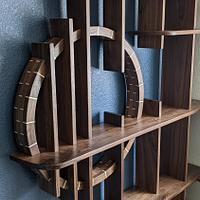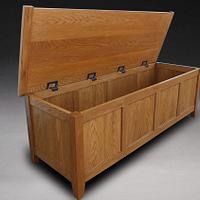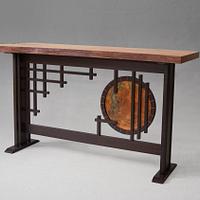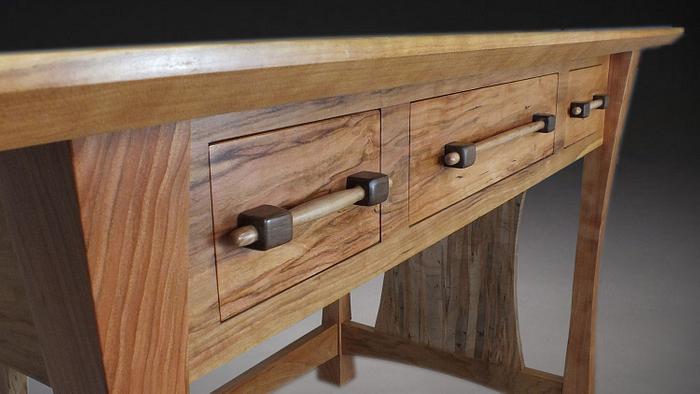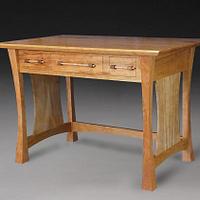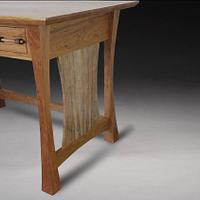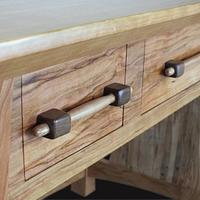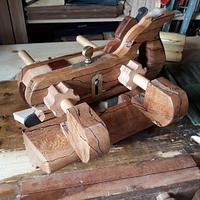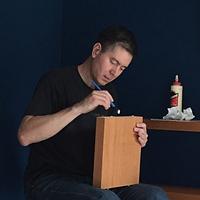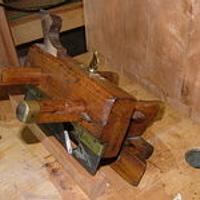Share your craft projects
Make new craft buddies
Ask craft questions
Blog your craft journey

Brian Benham
32 posts
and
13 followers
in almost 3 years
in almost 3 years
More from Brian Benham
Cherry Writing Desk
The Primary wood in this writing desk is made from American Cherry. The drawer pulls are ambrosia maple, set into walnut posts.
Sizes are approximate and can be customized to fit many situations.
30″ tall
46″ wide
28″ deep
Origin of This Piece
The first iteration of this cherry writing desk was for my daughter Brynn as she needed a place to do her homework. It’s interesting to look back at writing desk styles. We went from something that had a large drawer to store a typewriter to a desk with open spaces or shelves to store a PC computer tower on. But now we don’t need either a large drawer or shelf as my kids’ generation uses Ipads and tables that can easily slide into a small shallow drawer.
Not having this design constraint of storing large objects opens up more possibilities for designing the piece’s aesthetics. Such as the curve of the legs and having the space to mirror that curve in the accent panel.
I then carried this theme of mirroring design elements and used the same wood as in the accent panel in the drawer pulls. The ambrosia maple has a soft, light brown color to it that blends well with the cherry. I set the drawer pull into walnut posts. Often times it can become overwhelming in the visual presentation of a design to use a third type of wood. However, since the ambrosia maple and cherry blended well together, I couldn’t really say that the maple was a contrasting accent color but more of a complementary wood. So to bring your eye down to the drawers, I decided to use walnut to separate the maple from the cherry. The walnut stands out nicely against the drawer fronts.
For the part of the drawer pulls you grab onto, I deviated from a standard James Krenove straight-dowel drawer pull. I turned the maple on the lathe, creating a slight bulge in the dowel’s center. This created another level of detail and sophistication that only the user would notice as they opened the drawer.
For the drawer fronts, I dug through the entire stack of wood at the lumber yard to find a board with a beautiful grain pattern. When laying out the front apron, I was careful to keep all the parts in order so the grain flowed from one drawer front to the next. For the uninitiated, these design detail may be lost, but for those who appreciate the attention to detail, this is what sets this piece apart.
17 Comments
Very nice, Brian. Great design and use of the ambrosia maple. Major kudos!
Knowing how to use a tool is more important than the tool in and of itself. - Ron Aylor
Good to see you here Brian 👍
No lack of bling in your desk, great legs!
No lack of bling in your desk, great legs!
shear elegance as usual brian. love the shape you used on the legs. i hope you'll bring a bunch of your projects from that "other" place.
working with my hands is a joy,it gives me a sense of fulfillment,somthing so many seek and so few find.-SAM MALOOF.
Great looking table Brian - I really like the styling on the legs.
Really like the desk. design and use of the grain pattern does make the desk special. Nice work.
Ron
The first thing that came to mind was already expressed by Pottz. Elegant. Your daughter must be so happy. I’d buy one of those heavy gauge clear plastic top covers so she can enjoy it well into her adulthood.
The walnut works great with the other woods. It’s good to see you here. What made you decide to post here.
The walnut works great with the other woods. It’s good to see you here. What made you decide to post here.
James McIntyre
Beautiful desk! In particular, the curved legs give it an elegant look.
Curves and legs and character, whats not to like.
No Bees. No Honey. Bees Lives Matter
The grain across the front just sets this apart. As soon as I saw your name, I knew it would be a "desk with details." Thanks for sharing.
👍,🦆...
Nice pulls, nice curved legs... I'm not pulling your leg.
Nice pulls, nice curved legs... I'm not pulling your leg.
If your first cut is too short... Take the second cut from the longer end... LBD
Excellent work it looks great
Beautiful desk, sexy legs, nice curves throughout, and a wonderful grain match on the front drawers, the pulls take it over the top. Well Done. Welcome to Craftisian.
Main Street to the Mountains
The details on the legs and pulls take this to the next level!
Beautiful desk, nice work, and the drawer pulls add an elegant touch.
I want to reach out and touch the handles. Well done.
Fantastic design and execution.
Brian,
Lovely desk. The attention to detail is A+. Liked the video.
Lovely desk. The attention to detail is A+. Liked the video.
daveg, SW Washington & AZ









